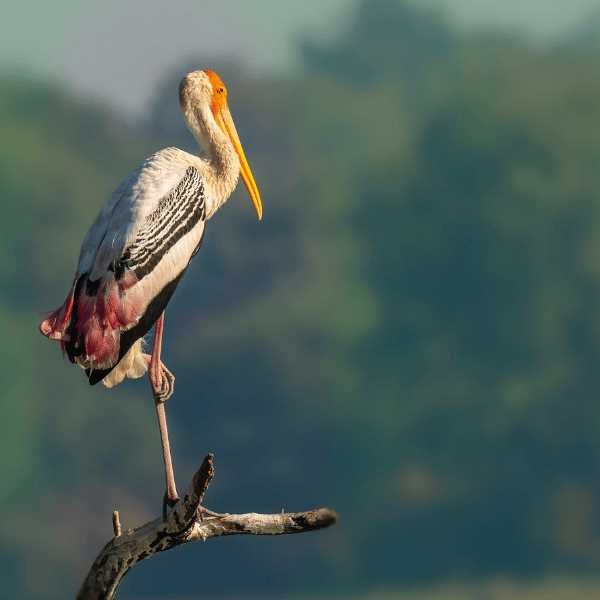Rajasthan
About Rajasthan
Rajasthan, popularly known to many as the Land of the Kings, is a beautiful example of India?s age-old opulence and grandeur, traces of which still linger in the air of this state. One of the most colourful and vibrant states in the country, with a strong blend of culture, history, music, cuisine and people welcoming you with smiling faces, falling in love with Rajasthan doesn’t take much time. Rajasthan has more history than the entire country put together- it is the realm of erstwhile Maharajas and their lavish palaces and majestic forts. Rajasthan is steeped in a past filled to the brim with honour, chivalry and heroism. Golden-sand deserts, traditional handicrafts, authentic cuisine and awe-inspiring palaces all contribute to making Rajasthan an ideal vacation spot.
Rajasthan also has a significant number of palaces that are of historical significance, the famous ones being the Umaid Bhawan Palace and the Jaipur City Palace. Both of these palaces date back to the high times, and you can see the furniture and other objects used by the royal families on view in these palaces.
Jaipur
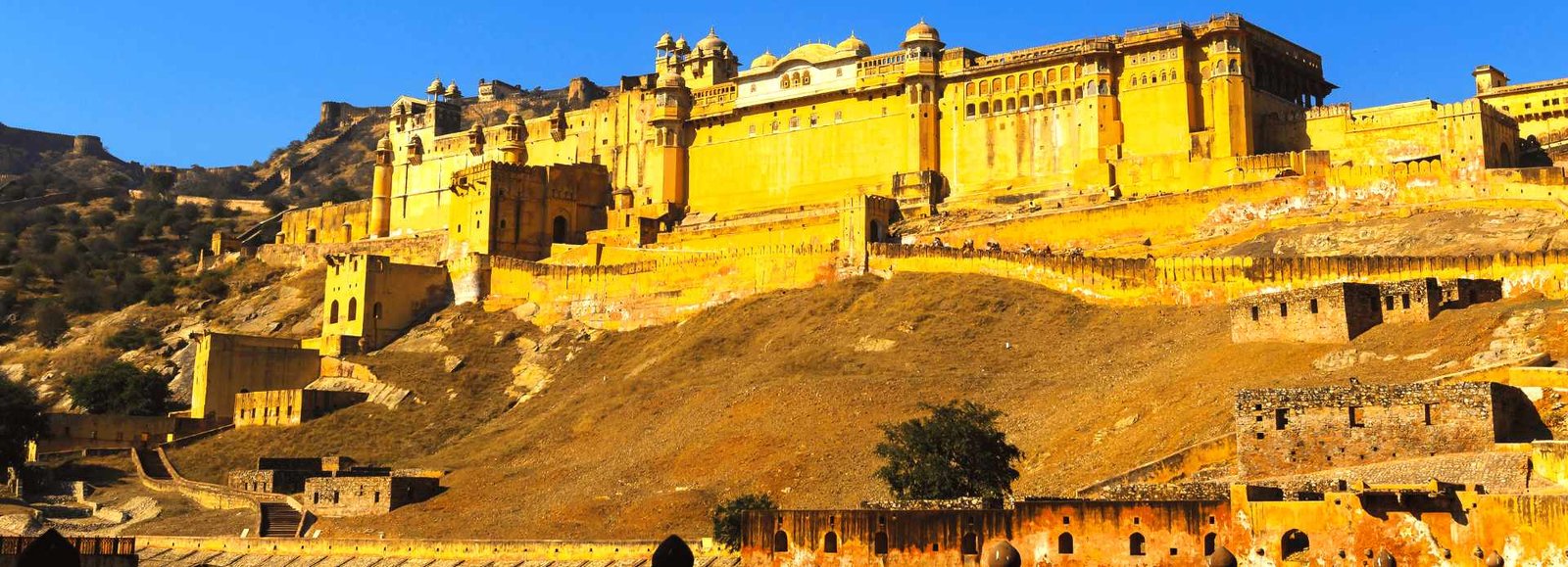
Rajasthan also has a significant number of palaces that are of historical significance, the famous ones being the Umaid Bhawan Palace and the Jaipur City Palace. Both of these palaces date back to the high times, and you can see the furniture and other objects used by the royal families on view in these palaces.
One of the largest cities in India, Jaipur is also home to all the modern amenities with some of the most exotic hotels and resorts in the world. The city boasts an international airport and is also very well connected by rail and road. The metro, local buses, shared tuk-tuks, auto-rickshaws and taxi aggregator apps including Uber and Ola solve the commute problem in the city quite comfortably.
Majestic buildings, tales of heroic battles, resplendent forts and palaces, and multi-faceted characters, Jaipur has long been one of the shiniest cultural jewels in the history of the Indian subcontinent. With people known for their hospitality, Jaipur offers a plethora of options for travellers.
Things to Do
Amber Fort
In the Pink City of Jaipur, cradled on the top of the Aravali Hill lies the Amer Fort, one of the most magnificent palaces in India. Also commonly known as the Amber Fort, this majestic building with its maze-like passages and serpentine staircases is an architectural masterpiece and with significant importance in Indian history. Only 11 kilometres away from the capital city of Jaipur, Amer Fort is clad in pink and yellow sandstone and is a part of an extensive complex. Built by one of the most trusted generals of Akbar, Maharaja Man Singh I in the year 1592, Amer Fort served as the main residence of the Rajput Rulers.
The Amer Fort through its large ramparts, several gateways and paved paths overlooks the Maotha Lake in the town of Amer, which used to serve as the capital of the erstwhile Jaipur princely state. The fort is big enough that it will take you at least two to three hours to explore it in detail, and you can also choose to avail of the audio guides to lead you through this fascinating building while explaining the history of the place. Getting an elephant ride up the stairs to the Amber Fort is also a popular tourist activity. The fort sees over five thousand visitors daily and rightfully, the Amer Fort was inducted into UNESCO World Heritage Site list as part of the “Hill Forts of Rajasthan” along with five other forts.
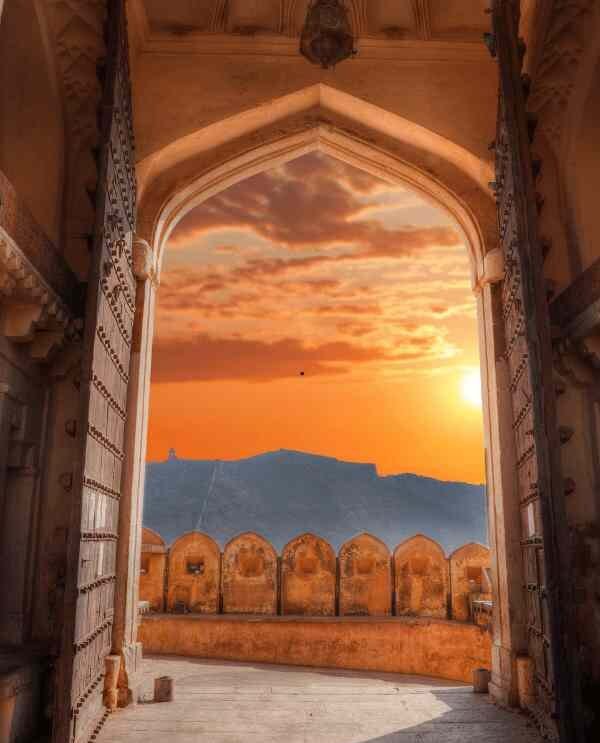
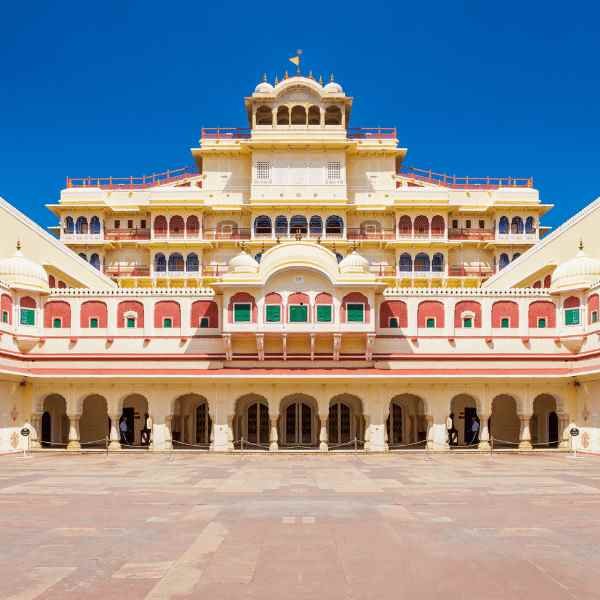
City Palace
The magnificent City Palace in Jaipur is one of the most famous tourist attractions located in the old part of the city. Built by Maharaja Sawai Jai Singh during the years 1729 to 1732, the vast complex of the palace occupied one-seventh of the walled city. In fact, it was once the seat of the Maharaja of Jaipur. The palace is divided into a series of courtyards, buildings and gardens including the Chandra Mahal and the Mubarak Mahal. The museum showcases various unique handcrafted products and other things that belong to the royal heritage of the City Palace.
The facade itself is designed with acute and detailed handiwork and showcases a blend of Mughal and Rajput architecture styles. The outer wall was built by Jai Singh II, however, the palace itself has been subjected to various changes over the course of time, with some of them even belonging to the early 20th century. The City Palace has three gates, out of which the Virendra Pol and Udai Pol are open to the public.
Hawa Mahal
The massive edifice of Hawa Mahal stands at the intersection of the main road in Jaipur, Badi Chaupad and was built by Maharaja Sawai Pratap Singh in the year 1799. Hawa Mahal derives its name from its unique structure, which is a mesh of small windows that allowed cool wind to enter the palace and hence kept the palace comfortable during the hot summer months. The main reason behind the palace’s construction was to allow the women of the royal house to observe the festivities on the streets whilst being unseen from the outside as was the custom of the land. It is located right on the edge of the City Palace Jaipur and extends right to the ‘zenana’.
Hawa Mahal is a structure made of red and pink sandstone and has a pyramidal structure which almost resembles a crown. It has been embellished with 953 tiny windows, also known as ‘Jharokhas’ and embellished with gorgeous latticework. From within, the Hawa Mahal palace is based on five floors each of which has a uniquely decorated chamber. A charming fountain welcomes you inside the main palace, from whereon you can make your way up to the different floors. The top of the palace offers a brilliant view of the City Palace, Jantar Mantar and the ever-busy Siredeori Bazar. There is a small museum as well which holds some rich relics and miniature paintings.
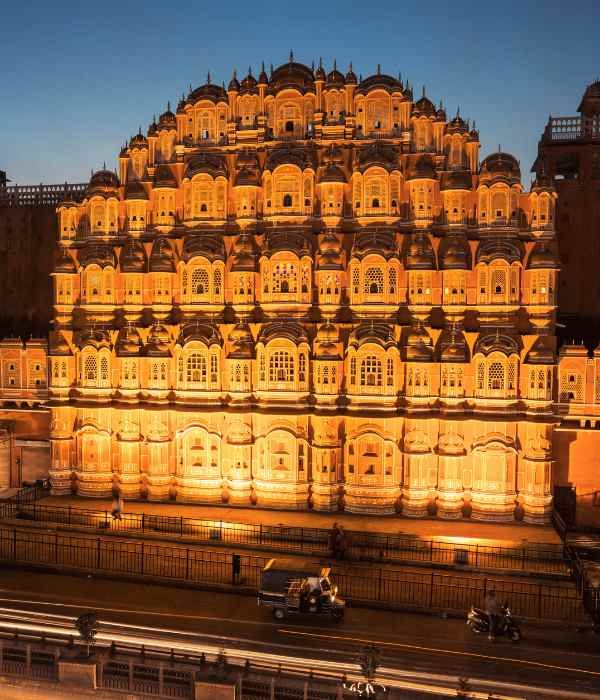
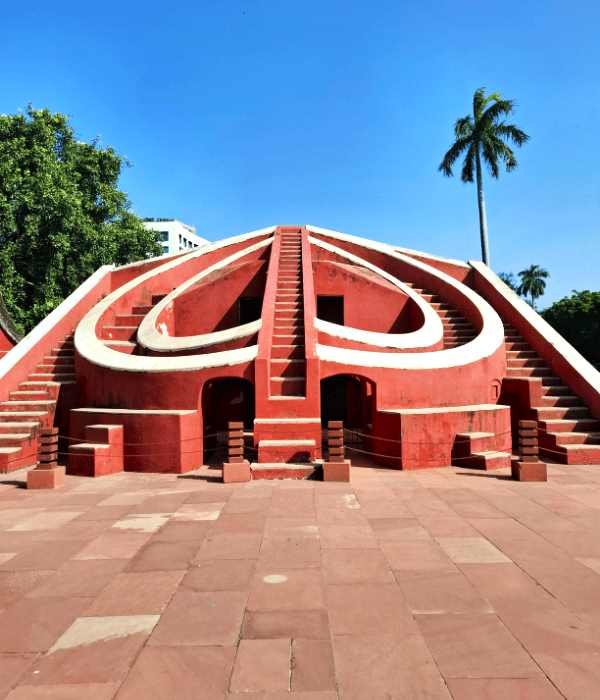
Jantar Mantar (Observatory)
Located near the City Palace in the regal city of Jaipur, Jantar Mantar is the largest stone astronomical observatory in the world. Owing to its rich cultural, heritage and scientific value, Jantar Mantar in Jaipur has also been featured on UNESCO’s list of World Heritage Sites. This ancient study boasts of nineteen instruments built out of stone and brass and was built by Raja Sawai Jai Singh in 1727-33. The intelligent construction and placement of these instruments allowed the observers to note the position of heavenly bodies with their naked eye alone. Time has failed to lay dust upon this engineering marvel and it still works as well as it used to in the olden times.
The main objective of building this vast observatory was to study and gather information about space and time. The instruments here pertain to Egyptian study of Ptolemaic astronomy and follows three classical celestial coordinates to track the positions of heavenly bodies- namely horizon-zenith local system, the equatorial system and the ecliptic system. Another fact that makes this destination unique is that the world’s largest sundial is situated here. The observatory in Jaipur is a part of a collection of five other such observatories built by Raja Jai Singh, which are located in New Delhi, Ujjain, Varanasi and Mathura. The best experience here is undoubtedly the light and sound show that takes place every evening and Jantar Mantar lights up like a firefly!
Pink City
Pink City in Jaipur refers to the old walled city that was built in the year 1727 by Maharaja Jai Singh II. This was declared a UNESCO World Heritage Site as of June 6th 2019. The wall that marks the boundary of the Pink City is about six metres high and three metres thick and encompasses a number of structures within its confines. In keeping with the magnificence of the structure, there are seven different gates that provide access to the Old City, namely Chand Pol, Suraj Pol, Ajmeri Gate, New Gate, Sanganeri Gate, Ghat Gate, Samrat Gate and Zorawar Singh Gate. Built about 275 years ago, today it presents the glorious past of our country through its culture and architecture. The city is known as ‘Pink City’ as it is built out of Sandstone and reflects the colour pink in the daytime.
Steeped with rich past and heritage, the Pink City of Jaipur is a place of royal heritage, culture and architecture. The city is covered in the tint of pink colour oozing charm and attracting tourists from all over the world. The place offers a feast to its visitors in the form of its historical saga with magnificent palaces and forts and stunning Havelis. A number of important structures such as Badi Chaupar, Jantar Mantar and City Palace are situated in this part of the city. The vibrant bazaars of Jaipur like Bapu Bazaar and Johri Bazaar are paradise for shopping lovers offering beautiful Rajasthani jewellery, fabric, shoes and handicrafts. Bustling with colours, a walk around this old city gives you a glance into is the wealth of handicrafts, the royal legacy of the palace, and a shadow of their rich past.


Udaipur
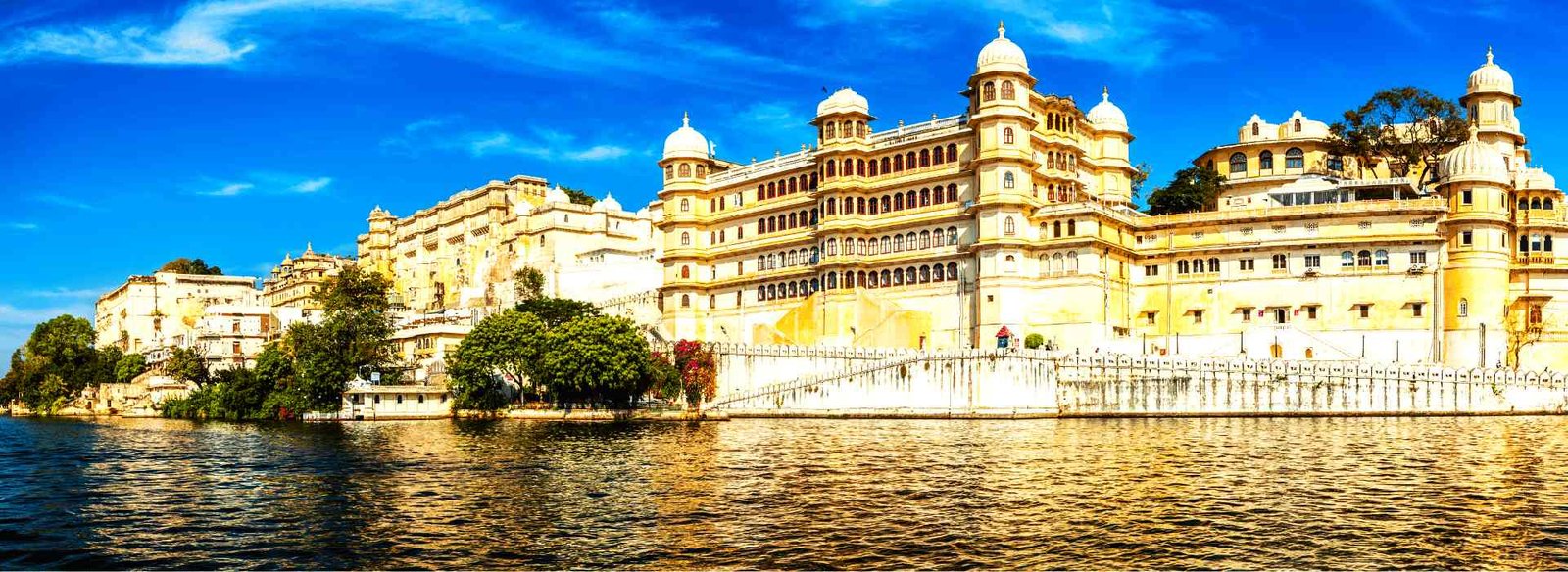
Udaipur, also known as the City of Lakes, is the crown jewel of the state of Rajasthan. It is surrounded by the beautiful Aravalli Hills in all directions, making this city as lovely as it is. This ‘Venice of the East’ has an abundance of natural beauty, mesmerising temples and breathtaking architecture which makes it a must-visit destination in India. A boat ride through the serene waters of Lake Pichola will be enough to prove to you why Udaipur is the pride of Rajasthan.
Located in a valley and surrounded by four lakes, Udaipur has natural offerings with a grandeur multiplied by human effort, to make it one of the most enchanting and memorable tourist destinations. It justifies all names ever offered to its charm from ‘Jewel of Mewar’ to ‘Venice of the East’. And though the entire city’s architecture is flattering, the Lake Palace hotel is something that offers the city a visual definition. The revered Nathdwara temple is about 60 km from Udaipur.
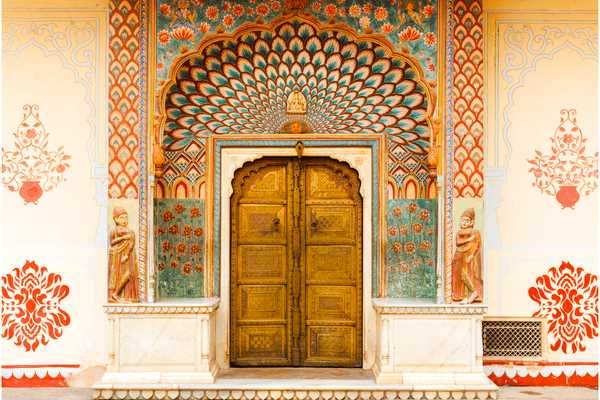

City Palace
Built on the banks of Lake Pichola, the City Palace in Udaipur is considered to be the largest royal complex in Rajasthan. The magnificent palace was built in the year 1559 by Maharana Uday Singh and served as the main seat of power, where the Maharanas lived and administered the kingdom from. Subsequently, the palace was made even more splendid by his successors, who added a number of structures to it. The Palace now has an assortment of Mahals, courtyards, pavilions, corridors, terraces, rooms and hanging gardens. There is a museum here as well that showcases some of the finest elements of Rajput arts and culture – from colourful paintings to the typical architecture found in Rajasthani palaces.
Nestled in the bosom of the Aravallis, the granite and marble edifice of the City Palace stands in contrast to its quaint natural surroundings. The intricate architecture of the regal palace is a subtle mix of medieval, European as well as Chinese influences and is embellished with numerous domes, arches and towers. The City Palace itself lies on a bed of lush green garden and is quite an imposing sight to behold. The regal beauty of this attraction has quite a few fans in the film industry as well, and several movies such as ‘Guide’ and ‘Octopussy’ have been shot here. A gentle amalgam of architectural genius and rich heritage, the City Palace of Udaipur is a wonderful trip down the pages of history.
Jagdish Temple
Dedicated to the preserver of the universe, Lord Vishnu; the Jagdish Temple is a grand and majestic structure that stands in the City Palace Complex of the breathtaking city of Udaipur in Rajasthan. Jagdish Temple is dedicated to Lord Vishnu, also known as Lord Laxmi Narayan and is reputed for being the most significant temple in the entire city of Udaipur. In fact, the gateway to this grand temple can be seen from the Bara Pol of the City Palace. Beautiful carvings, numerous appealing statues and an atmosphere of serenity make this place of worship an ideal choice for seekers of solace and faith.
The main shrine houses the striking four-armed statue of Lord Vishnu, which is carved out of a single piece of black stone. The main shrine of Lord Jagdish is centrally located, encircled by four smaller shrines. These shrines are dedicated to Lord Ganesha, the Sun God, Goddess Shakti and Lord Shiva respectively. The atmosphere inside the shrine is enveloped with utter calmness and serenity and is an experience that you definitely should not miss.

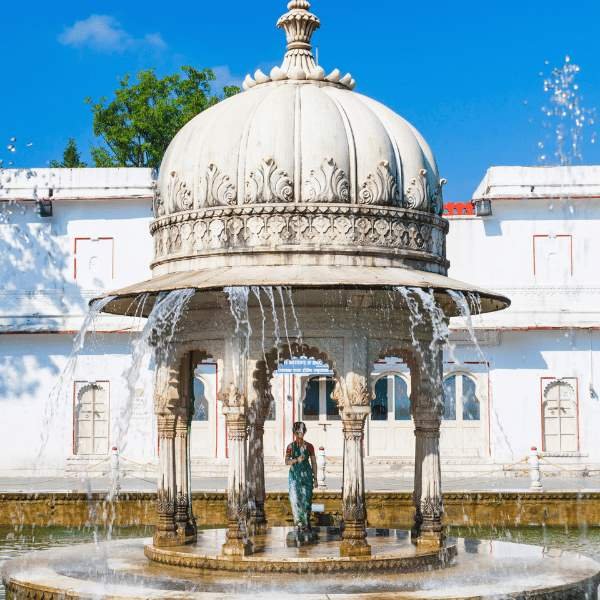
Sahelion ki Bari
Saheliyon Ki Bari is a majestic garden in the city of Udaipur, Rajasthan, India. It is also known as the Garden or the Courtyard of Maidens. As the name suggests, it was made for the maidens who accompanied the Princess after her marriage to Maharana Sangram Singh. The mesmerizing Saheliyon Ki Bari is located on the banks of the Fateh Sagar Lake in Udaipur. It has beautifully landscaped lush green lawns, canopied walking lanes and magnificent fountains. Most visitors think Saheliyon ki Bari is one of the best places in Udaipur to relax and rejuvenate with friends, family or even alone. The history, the traditional architecture and the regal vibe attract tourists from all over the world.
Saheliyon ki Bari is an 18th-century monument which is considered of immense historical importance in India. It is beautifully landscaped with tall trees, lush green shrubbery and flower beds. The beauty of the garden increases two folds by the majestic fountains and gorgeous lotus pool with marble pavilions and statues.
Lake Pichola
The Lake Pichola is an artificial lake located in the heart of Udaipur, Rajasthan. The oldest and one of the largest lakes of the city, the Lake Pichola observes lakhs of tourists because of its tranquillity and beauty. Flanked by lofty hills, heritage buildings and bathing ghats, it is a dream come true for peace and nature lovers. A visit to the Lake Pichola is incomplete without a boat ride, especially in the dawn. During evenings, it seems the entire place has been dipped in gold as you can see the heritage buildings and the pristine water turning golden with the sun’s reflection. The enthralling views will take you to a different world of stillness and will also bring out your romantic side.
Built by Pichhu Banjara during the ruling period of Maharana Lakha in 1362 AD, the Pichola lake is 3 miles in length, 2 miles in width and has a depth of 30 feet. Maharana Udai Singh, enchanted by the charm of the lake enlarged it and also constructed a dam on the shores of this lake. The lush green hills in the backdrop with many royal palaces along its banks is a cherry on the cake. The beautiful City Palace of Udaipur adorns the eastern banks while the Mohan Mandir is situated in the north-east corner. The renowned Lake Palace is perfectly perched in the middle, and there is the Jag Mandir on Jag Island.




Jagmandir Palace
Jag Mandir Palace (or ‘The Lake Garden Palace’), is a glorious palace located on the southern island of Lake Pichola in Udaipur, Rajasthan. The palace is three-storied and the structure is made out of marble and yellow sandstone. It would be a delight to see eight life-sized elephants carved out of pure white marble that seems to guard the palace. It was completed in the early years of the 17th century by Maharana Jagat Singh. The construction was started in 1551 by Maharana Amar Singh and continued by Maharana Karan Singh where it was served as a hiding place for Shah Jahan and was finally completed by Maharana Jagat Singh I.
On the trip to this palace, some of the most famous places to visit are Gul Mahal, where Shah Jahn lived with his family. This place is made in the style of Islamic architecture. A mosque was created here to serve the religious needs to Shah Jahan. Bara Patharon ka Mahal (made out of 12 slabs of marble), Kunwar Pada ka Mahal(palace meant for the enthroned prince), and the Zenana Mahal (chambers for the Royal ladies) are other must-visit pavilions. Jag Mandir Palace also has gardens embellished with roses, jasmine flowers, palm trees, frangipani trees, and bougainvillaea. The palace currently comprises of a restaurant called ‘Darikhana’ that serves lip-smacking Rajasthani food. You can also check out the museum where the history of the place has been reserved.
Vintage Car Museum
Located just a few kilometers away from the magnificent City Palace Vintage Car Museum is an awesome place for automobile and car lovers.
Moving away from the grand forts, castles and pristine lakes that Udaipur is so well known for, the Vintage Car Museum makes an interesting diversion. The museum is a collection of a good many vintage automobile models used by the Mewar dynasty of Udaipur. The Mewar dynasty happens to be one of the most opulent Rajput rulers, leading plush and luxurious lifestyles. Here at the Vintage Car Museum, you will get a tiny glimpse of it in the Rolls Royce and Mercedes models, which were previously custom-made and owned by the royal members of the Mewar family.
The premises of the museum was originally the Mewar State Motor Garage, or the Palace Garage, now under the HRH group owned by the current heir of the Mewar family, Rana Shri Arvind Singh Mewar. The museum was inaugurated by Lord Montagu of Beaulieu, the founder of the National Motor Museum of England on February 15, 2000. Among the most popular displays of the Vintage Car Museum are the 1934 Rolls Royce Phantom which was used in the famous James Bond movie Octopussy and the Cadillac convertible that escorted Queen Elizabeth back to the airport in 1961. There are around 20 more antique pieces here that you can feast your eyes on if you are a motor lover, like four more Rolls Royces, one MG-TC Convertible, two Cadillacs, one Ford-A Convertible, one Vauxhall-12 and solar-powered rickshaws.


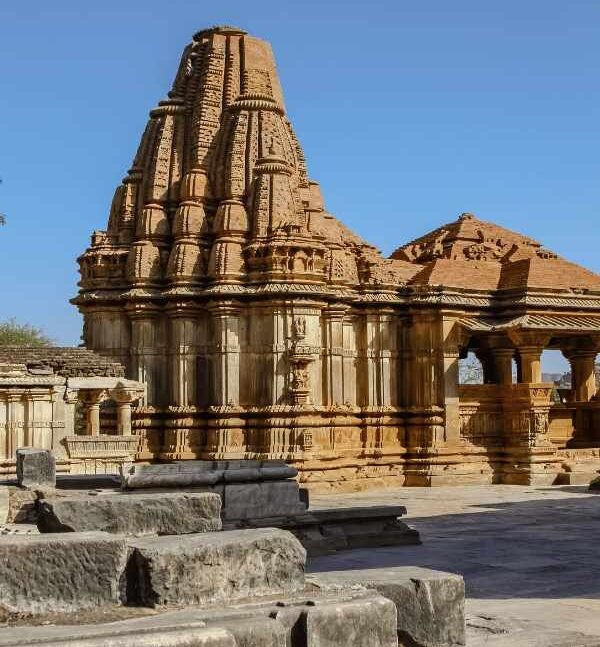
Eklingji Temple
Eklingji Temple is one of the most popular temples of Rajasthan and is sited at a distance of 22 km to the north of Udaipur. Eklingji Temple is dedicated to the Lord Shiva of the Hindu religion and its brilliant architecture drives several tourists here every year. This double-storied temple looks magnificent with its pyramidal style of roof and uniquely carved tower. The outer walls of the temple are stretched with steps that lower touching the serene waters.
Established in 734 A.D. by Bappa Rawal, Eklingji is purported to have been the ruling idol of Mewar rulers. On entering this hall, you would see a beautiful silver image of Nandi and inside the temple, there are two other images of Nandi carved in black stone and brass respectively. This temple is filled with an enthralling fragrance and is known for a striking four-faced idol of Eklingji (Lord Shiva) that is made out of black marble. Its height ranges around 50 feet and its four faces depict four forms of Lord Shiva. The Shivlinga garlanded by a silver snake is a major tourist attraction.
Ranakpur
Ranakpur is a small quaint town nestled amid the secluded valley of Aravali Ranges in Rajasthan. Situated around 96 km North of Udaipur in Pali district, it is an important destination for Jain pilgrims. The place presents a unique spectacle of verdant greenery and gushing streams, an unusual sight in Rajasthan. Immersed in the vibrant culture with a myriad of enrapturing beauty in store, Ranakpur has made its way on the list of must-visit destinations in Rajasthan.
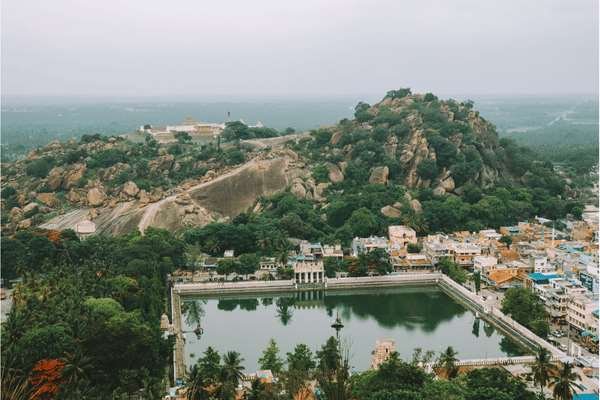
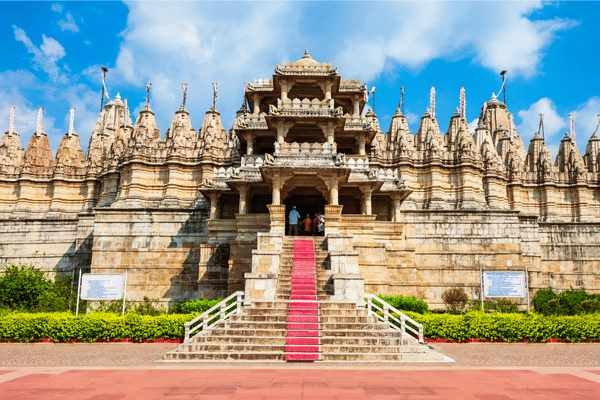
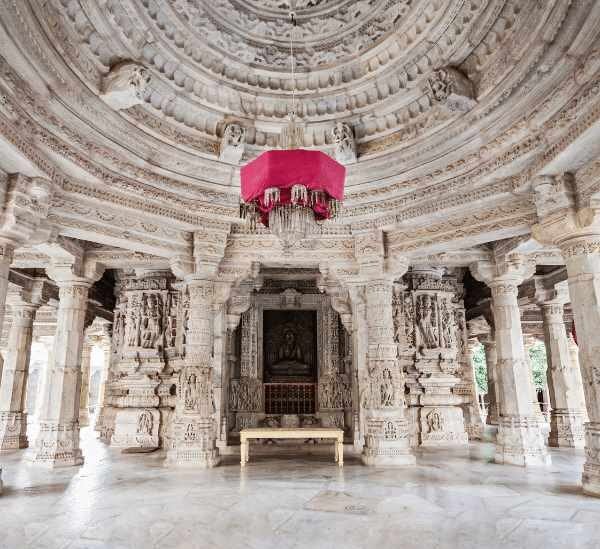
Ranakpur Jain Temple
Spread over an area of 4,500 square yards and consisting of 29 halls, the Ranakpur Jain Temple is one of the most important of the five major pilgrimage centres of Jainism. Also known as Chaturmukha Dharana Vihara, the temple dedicated to Tirthankara Rishabhanatha is located in Pali district of Rajasthan. The Ranakpur Temple is distinguished all across the globe for its brilliant architecture and was voted amongst the top 77 wonders of the world.
The temple honours Adinath, who was the first Tirthankar of the present half-cycle or ‘avasarpi’ according to Jain cosmology. Built during the reign of the Rajput monarch Rana Kumbha in the 15th century, the temple complex consists of a total of four shrines. The construction of the temple was undertaken by Dhanna Shah, a local Jain businessman who saw a divine vision. The architectural style and stone carvings of the Ranakpur Temple are based on the ancient Mirpur Jain Temple that is located at Mirpur in Rajasthan.
The temple is designed as a ‘chaumukha’, which means that it has four faces. This beautiful and marvellous structure carved in stone is well known all across India for its fantastic architecture style. The unique thing about the temple is its colour-changing columns. They go from golden to pale blue after every hour that passes during the day. Moreover, each of these columns has been carved intricately without repeating any designs. Hence, no two columns in the temple have similar designs. The two large bells in the prayer hall give a harmonious sound upon their movement and are like a cheerful song to the ears of the devotees.
Jodhpur
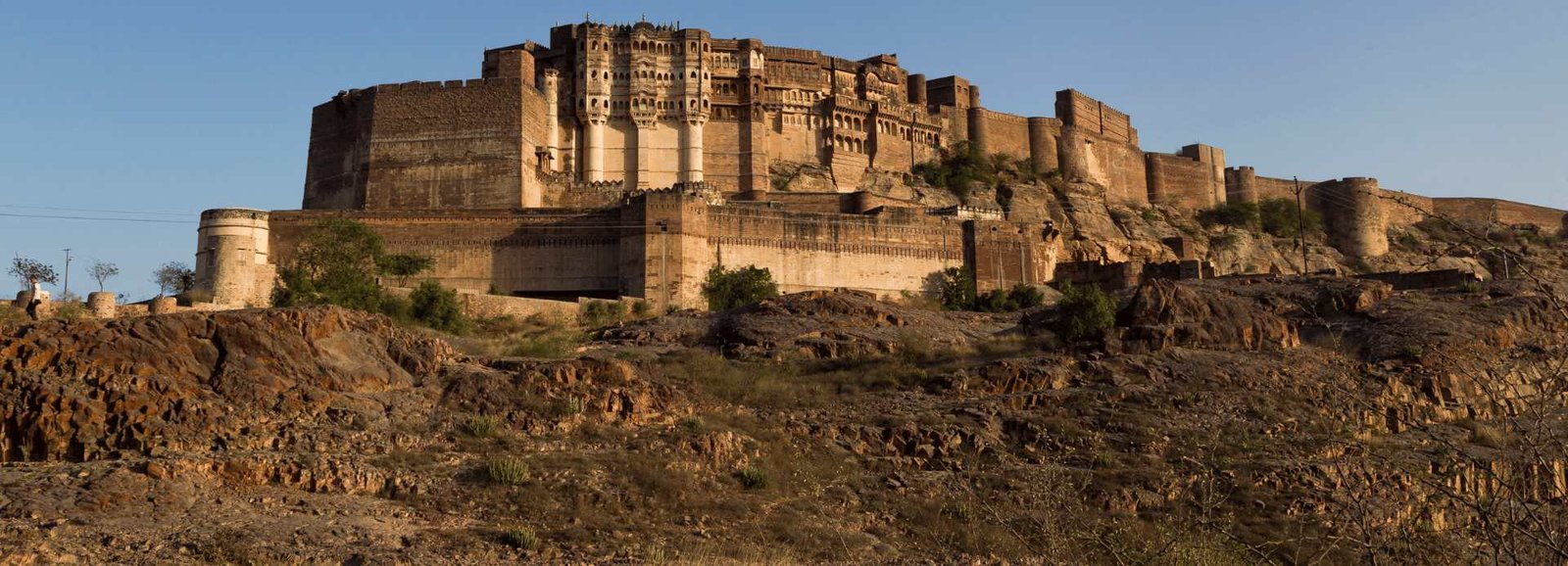
Also known as the “The Blue City”, “Sun City” and “Gateway to Thar”, Jodhpur is famous for its Mehrangarh fort, blue houses, temples, sweets and snacks. Apart from the fort, there are multiple temples, lakes, shopping streets that are like a mirage from a bygone era.
The former capital of Marwar, Jodhpur is one of the most enchanting cities of Rajasthan, with its mighty Mehrangarh fort overlooking the city. The city is called the Blue City as it looks completely blue in colour from an aerial view because of its blue walls and blue houses. Nearby Jaswant Tada and Umaid Bhawan Palace are also among the top attractions in Jodhpur. However, the magic lies in the old city itself with hundreds of shops, guesthouses; eating joints and vendors make it a chirpy bustling city, especially near the landmark clock tower and Sardar Market.
Seen in the backdrop of the movie, The Dark Knight Rises, Jodhpur attracts hundreds of thousands of visitors from all over the world. Jodhpur is conveniently located in the centre of Rajasthan making it easier for people visiting Jodhpur to explore other destinations of the state.
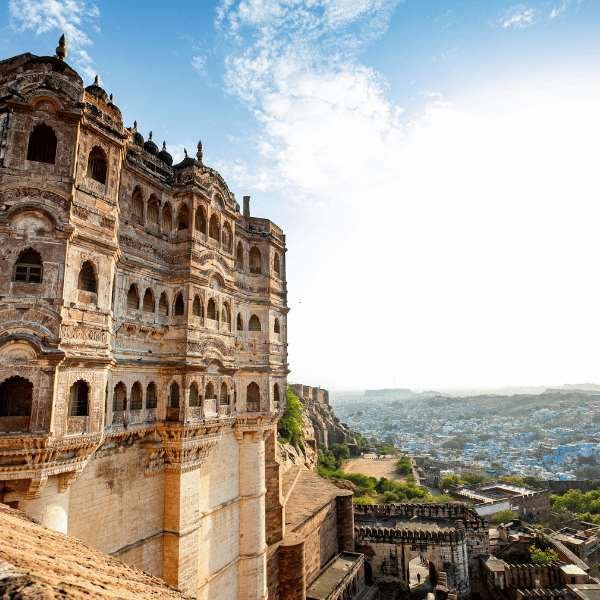
Mehrangarh Fort
Mehrangarh, also known as Mehran Fort was built by Rao Jodha in 1459 in Jodhpur, is one of the largest forts in the country. It is situated at the top of a 410 feet elevated hill and guarded by massive walls. One of the most easily recognisable forts in Jodhpur, it has appeared in many Hollywood and Bollywood productions such as The Lion King, The Dark Knight Rises, and the more recent – Thugs of Hindostan. The entrance of the fort, atop a hill, is majestic and has seven gates. These are called Victory Gate, Fateh Gate, Gopal Gate, Bhairon Gate, Dedh Kamgra Gate, Marti Gate and finally Loha Gate. Each of these was built at different times and serves a very specific purpose. While one still has marks of cannon balls being hit on it, the other has spikes that can protect it from elephant and animal attacks. However, Victory Gate was built to commemorate the win of Maharaja Man Singh over Jaipur and Bikaner armies. The fort also has opulent palaces such as the Sheesh Mahal (Glass Palace) and Phool Mahal (Rose Palace).
Jaswant Thada
In the royal state of Jodhpur lies Jaswant Thada, a splendid marble cenotaph monument that is also a mausoleum for the kings of Marwar. The memorial was built in the honour and memory of Maharaja Jaswant Singh II by his son Maharaja Sardar Singh in 1899 and is still used by the Marwar Royal Family as cremation grounds. The beautiful edifice is made out of intricately carved marble that is offset vibrantly against the red steps that lead up to the entrance. Jaswant Thada in Jodhpur is considered as an architectural landmark and must be seen by one and all. On the steps leading up to the monument, one can see local musicians and folk dancers entertain the visitors.
The cenotaph also has a beautifully maintained garden which the tourists can explore along with the monument. You can explore the intricate artistry on the carved marbles. The skilfully carved thin sheets of marble are worth appreciating. The entire structure resembles a temple with unmatched beauty. It is also called the Taj Mahal of Marwar and attracts tourists from all over the world.
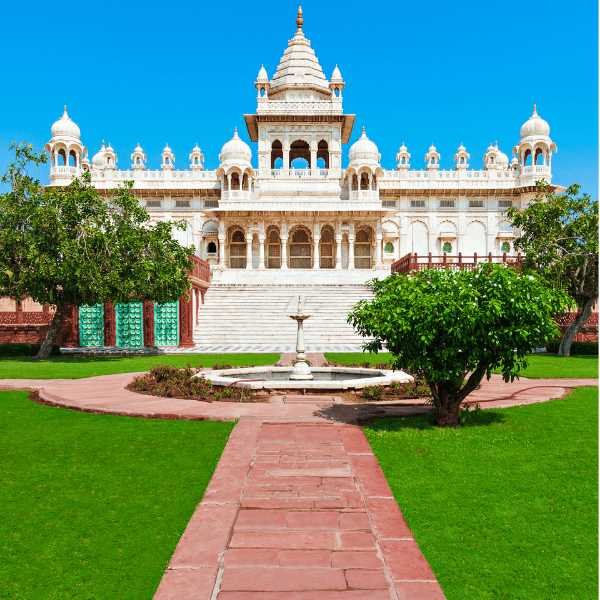

Ghanta Ghar
The Ghanta Ghar in Jodhpur is a magnificent clock tower in the centre of the city, built by Maharaja Sardar Singh about 200 years ago. Known as the clock tower of Rajasthan, it is a popular landmark that signifies the start of Old Jodhpur. The tower offers a brilliant panoramic view of the city from the top. The area surrounding this imposing structure is bustling with locals presenting all sorts of products and services, making it the busiest and largest marketplace of Jodhpur. The markets and the tower are a must visit for travellers who want to witness and experience the culture and people of Jodhpur.
The clock tower is surrounded by street markets, with the most famous amongst them being Sardar Market, named after the late king. One can find a variety of people in this locality, representing all walks of life. At night, the tower comes to life when it is all lit up, making for a glorious end to a day well spent at this bountiful market.
Jaisalmer

Jaisalmer is a major tourist spot located in the northwestern state of Rajasthan in India. It is known as the ‘golden city’ due to its bounteous golden dunes and castles clad in golden honey sandstone. Jaisalmer is adorned with lakes, ornate Jain temples and havelis. Climb on to the camel saddle and make your way through this desert or camp under the night sky in this golden land for an unforgettable experience.
The Jaisalmer Fort stands as a citadel and is surrounded by narrow alleys inhabited by people residing there for generations. With shops selling colourful handicrafts and havelis that will make you travel back in time, Jaisalmer is an amalgam of exotic Indian desert culture, heritage and adventure.
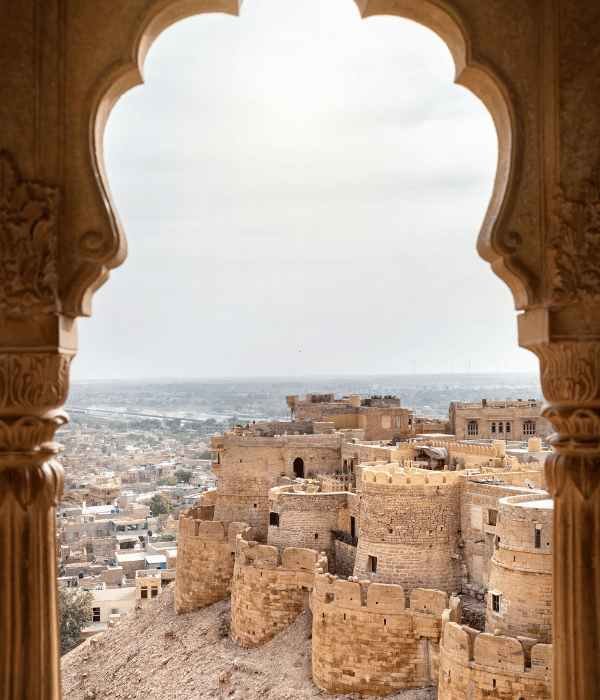
Jaisalmer Fort
Jaisalmer Fort, nestled on the golden sands of Thar Desert, is not just a fort but a mini-town with houses, temples, shops, and restaurants. A UNESCO World Heritage Site, it falls under the category of ‘Hill Forts of India’. Built in 1156, Jaisalmer Fort gets its name from the former Bhati Rajput ruler Rao Jaisal. More than three thousand people live within the fort walls with multiple entrance gates on the path up top, the last of which directs you to the popular public square named Dashera Chowk. The fort stands at an impressive height of 250 ft. and is surrounded by a 30 ft. tall walls. Owing to its altitude, it offers a stunning and panoramic view of Jaisalmer city draped in golden yellow!
One of the largest forts in the world, Jaisalmer Fort is located on the southern edge of the city and is popularly known as ‘Sonar Qila’ or ‘Golden Fort’. It is a massive structure exhibiting its aesthetic beauty. The walk through the labyrinthine lanes is an experience worth having. Jaisalmer Fort was initially named ‘Trikut Garh’ since it was triangular in shape and was also built over the Trikuta Hills. ‘Sonar Qila'(Golden Fort) as it is locally referred to, houses almost quarter of Jaisalmer’s population inside the complex.
Jain Temple
Situated in the Jaisalmer Fort, Jain Temples in Jaisalmer are a must-visit while you are in the city. The temples, though ancient, have a high religious significance and ancient knowledge attached to them. Built in the Dilwara style that is famous all over the world for its architecture, these temples are dedicated to Rikhabdevji and Shambhavdev Ji, the famous Jain hermits known as ‘Tirthankaras’. Being a significant pilgrimage spot, the Jain Temples are truly a treasure of the Jaisalmer city and a fun place to be at for all those tourists who are interested in history and religion. All the seven temples are connected to each other and are built using the same golden-yellow Jaisalmeri stone.
Each temple appears as a riddle to the visitors having its own tale to narrate. These temples dedicated to Rishabhdev, Sambhavnath, Chandraprabhu, and Parsvanath have the most exquisite carvings imprinted on them. One can enjoy the stunning sculptures around the walls which are protected by glass cupboards and pillars carved with Gods and celestial women.
If anyone is especially interested in finding the ancient remains and history of these temples, there is a place present just for that- the Gyan Bhandar. As the name suggests, the Gyan Bhandar is a very tiny and attractive library founded in 1500. Priceless old texts and manuscripts are present in the library. Jain Temples in Jaisalmer are a must-visit, especially if architecture and history interest you.
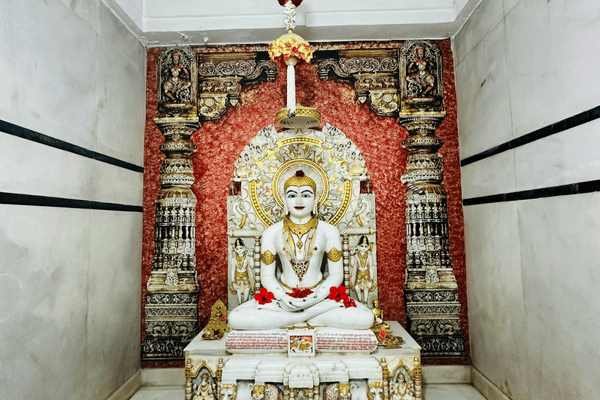

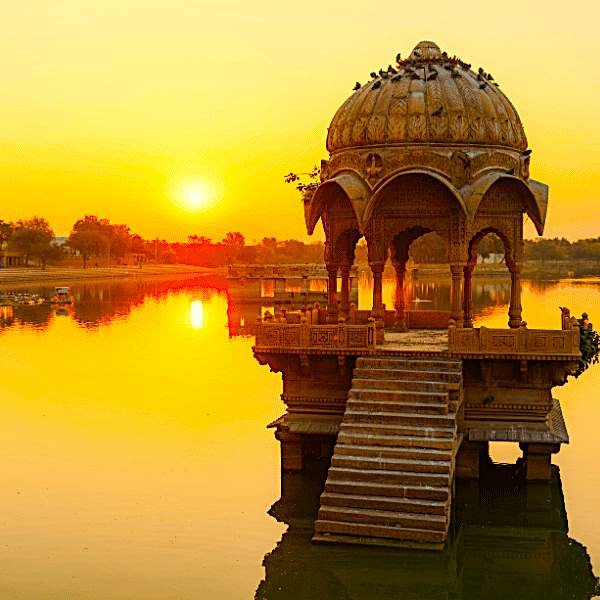
Gadisar Lake
On the outskirts of Jaisalmer in the arid state of Rajasthan lies the beautiful Gadisar Lake, which sits like an oasis in the heart of a desert. Back in the middle ages, there were no canals or irrigation system or other scientific methods to bring water to the arid regions of Rajasthan. This reservoir was built by Raja Rawal Jaisal keeping in mind the need of his people. Located close to the fort of Jaisalmer, the lake is an easy respite from the hot and dry desert climate. Gadisar Lake offers scenic and picturesque views of the lake and the adjacent fort, especially when the eastern sky is blood red and the sun rises, striking its rays on the top floors of Jaisalmer Fort.
Whether you like to spend some quiet time by yourself or have fun with your family, Gadisar Lake has a handful of experiences to offer. You can go boating in the lake or simply enjoy a walk around the embankment. If winter is your time of visit, you might just be lucky enough to see beautiful exotic migratory birds flocking in and around the lake from the nearby bird sanctuary of Bharatpur.
Desert Safari
Jaisalmer in Rajasthan is a place frequently visited by tourists for its large stretches of desert sand. Most of the visitors prefer going for the desert safaris and planned packages. These tours are conducted either in the early morning or during the evening to avoid the scorching heat. Also, once the desert safari in Jaisalmer gets done, you can enjoy a delicious meal alongside musical dance program that showcases the local culture of Rajasthan. The desert safari is usually conducted in jeeps or personal cars; you can also enjoy the camel safari over the dunes that will give you a feeling of having stepped back in history. Although visitors usually prefer taking these safaris early in the morning, the night time is when the desert indeed comes alive.
Jaisalmer with its soft golden sand appears all the more beautiful. It is also known as the ‘golden city of Rajasthan’ and is also the place where the ancient Jaisalmer Fort is located. There are two types of Safari offered at the place namely Camel Safari and Jeep Safari in Sam Sand Dunes.
In camel safari, a camel rider is needed for the safari tour of 90 min. The same can be hired for a ride from a local tour operator. In jeep safari, one needs to travel for 45 km to Sam Sand Dunes. The only mode of transportation provided is a private cab.
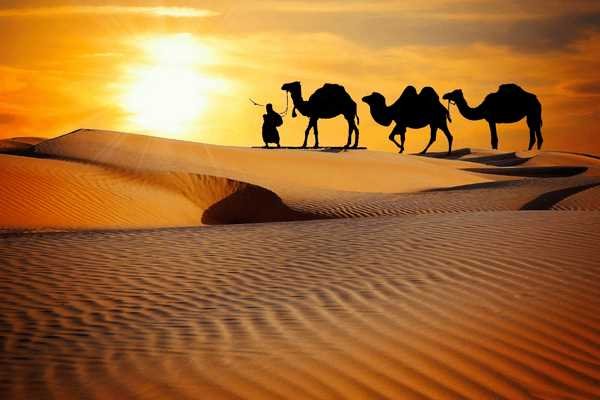

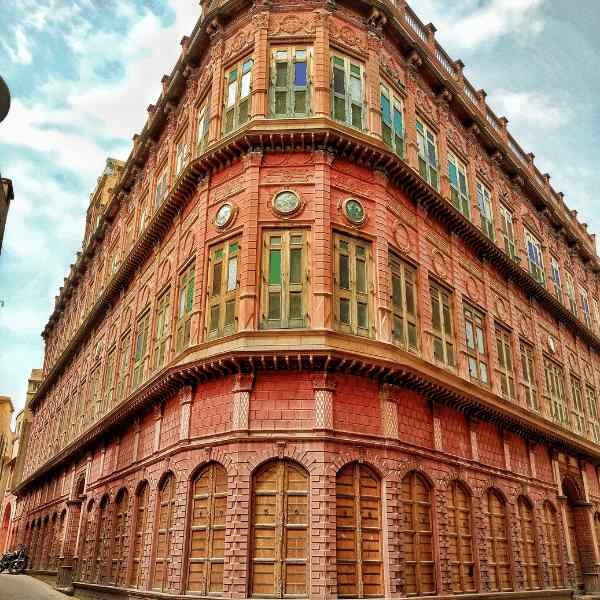
Bikaner
Located in the midst of Thar Desert, Bikaner is a “cultural paradise and a traveller’s haven”. Bikaner with its magnificence in architecture, art and culture is filled with colour, festivity and cultural marvels.The city will mesmerize you with the camels sauntering the beautiful sand dunes, its ancient palaces and forts. Rightly called as one of the three great desert kingdoms of Rajasthan, the dazzling city boasts of old-world charm, opulent havelis and depicts a pleasing bygone era of the Rajputs. Best known as the “camel country” for breeding some best-known riding camels, Bikaner also happens to house one of the only two models of the biplane used by the British in World War 1.
Sand Dunes and the Desert Safari are among major attractions. Bikaner is also famous for hosting the international Camel festival which draws tourists from the world over. Other attractions here include experiencing delicacies such as Thandai, Bhujias, shopping for the fascinating Ivory and Lacquer items or simply witnessing the immense heritage taking the form of wall paintings and arts and crafts in the area.
Junagarh Fort
The Junagarh Fort of Bikaner is a magnificent structure around which the city of Bikaner grew up. The fort was initially called Chintamani and was then renamed as the Junagarh or Old fort in the 20th century. The foundations of the Junagarh fort was built in 1478 by Rao Bika. However, it existed just as a stone fort then. The present grand structure was inaugurated on 17th February 1589. Besides having a rich history, the Junagarh Fort is a feat of architecture. The palaces inside the fort, the gardens, balconies, kiosks, etc. depict a composite architectural style which is influenced by the cultural differences of the different rulers and also foreign inspirations. The impressive Junagarh Fort stands with all its regal glory as an epitome of architectural brilliance. The dazzling and exquisite structures of this fort attract thousands of tourists from all over every year.
The unique monuments which are on display in the fort represent 16 generations of rulers in Bikaner starting from the late 16th century. Junagadh is an ancient fortified city with a chequered past and has an eclectic mix of mosques, Hindu temples, Buddhist monuments, Gothic archways, and beautiful mansions.
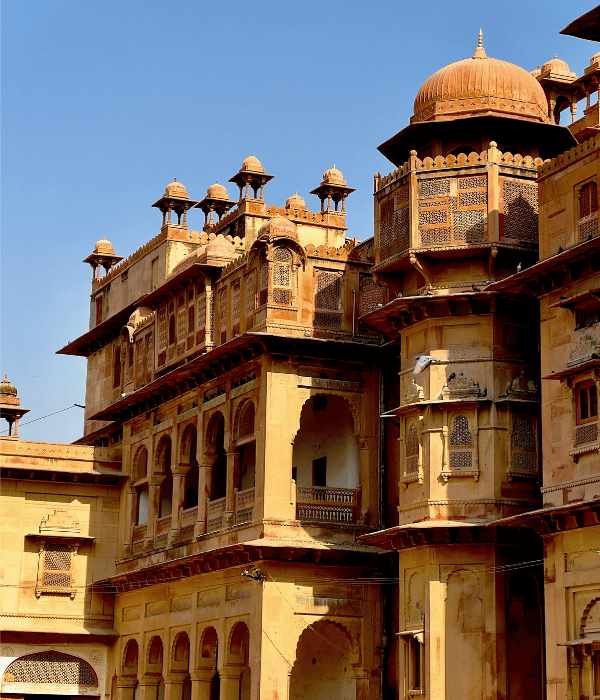
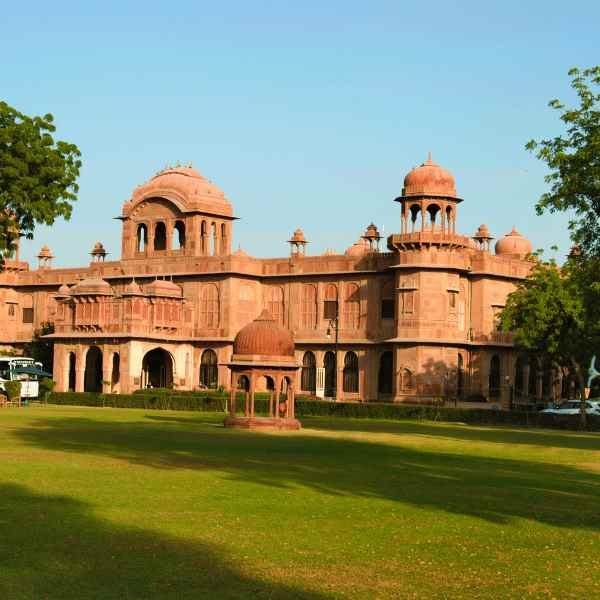
Lalgarh Palace
Lallgarh Palace, a breathtaking Rajasthani Palace, is located in the beautiful city of Bikaner, Rajasthan in India. It was constructed for the Maharaja of Bikaner, Maharaja Ganga Singh, between 1902 and 1926. The palace built in European architecture style has now been opened up for tourists as a Heritage Hotel and the entire estate comes under the National Heritage Trust. The estate also houses a museum named Shri Sadul Museum, where you can find traces of Rajasthani Royalties and get an insight into their extravagant lifestyle.
Built with red sandstone bought from the Thar Desert, the colours of the beautiful structure when they change shades as the day progresses. If you wish to stay at the Lallgarh Palace Hotel, you’ll be amazed at the massive size of the rooms you’ll be living in and the regal hospitality you’ll be receiving. One of the estate wings has been maintained only for the Royal family of Bikaner. The other two wings are for The Lalgarh Palace Hotel and the Lakshmi Niwas Hotel.
Karni Mata Temple
The Karni Mata Temple, also popularly known as the Nari Mata Temple or ‘Rat Temple’, is a 600-year-old temple located around 30 km from Bikaner in a small town of Deshnoke in Rajasthan. What is unique about this temple is the fact that 25,000 black rats live, and are worshipped, in the temple. Infact, the food that is eaten by them is considered to be holy and is later served as ‘prasad’.
These holy rats are known as kabbas, and people from all over the world travel great distances to come and visit the temple to pay their respects to these rats. Numerous tales and legends are associated with the temple and the rats that live here, but no one knows the exact history of this unique shrine.
The Karni Mata Temple is also noteworthy for its architecture that has been influenced by the Mughal style of construction. The beautiful temple is adorned with a fantastic marble facade and marble carvings that further add to the charm of this place. While the entire concept of this temple may seem as gross or weird to some, it is a unique experience altogether and is something you should not miss out.

Pushkar
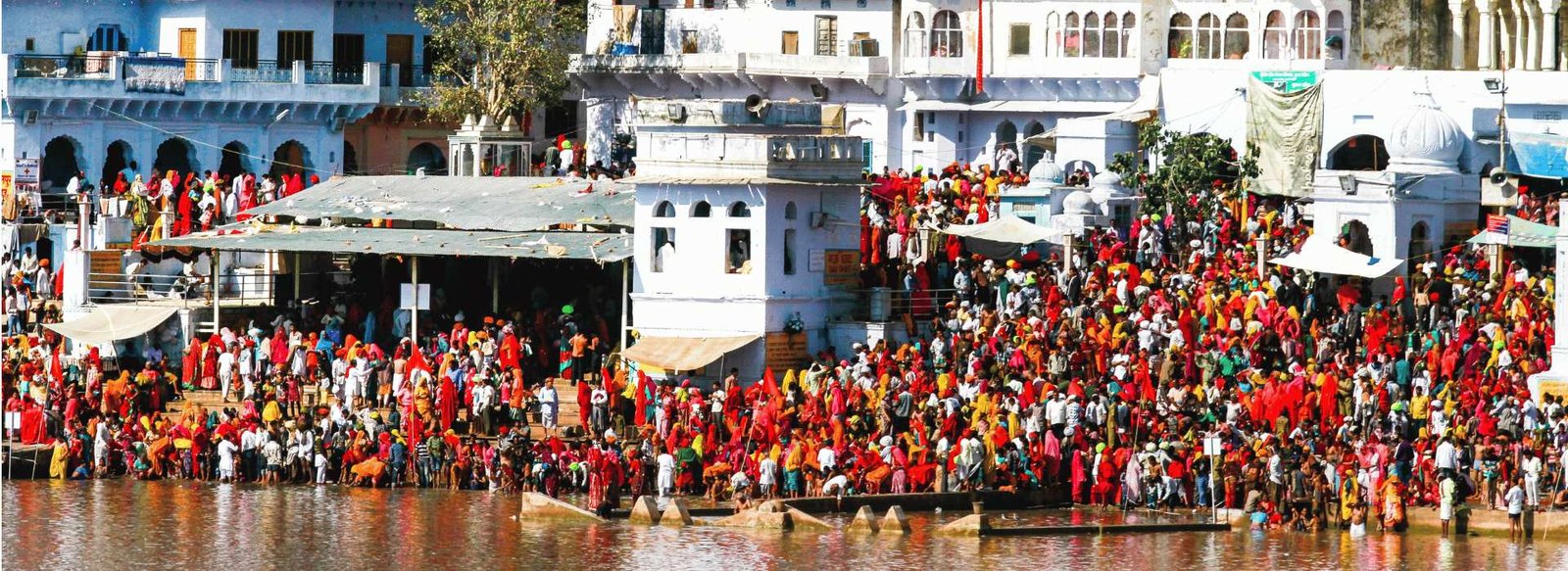
Pushkar, a small temple town, is located around 15 km from Ajmer in Rajasthan. Every November, Pushkar is host to the Pushkar Mela, one of the biggest camel fairs in the country. Perfect choice for a weekend getaway from Jaipur, Pushkar is located amid Aravali ranges. Known for the world’s only dedicated Brahma temple, Pushkar is primarily a pilgrimage site for Hindus.
Spend some evenings sitting at the ghats while sipping chai or taking a stroll through narrow alleys while listening to the chants from temples surrounding the ghats. A delight for street-shopping lovers, Pushkar has shops in the main street selling everything from silver oxidised jewellery to merchandise swaddled in various colours.
The Pushkar Mela attracts millions of visitors from around the world. With folk performances, rides, stalls and even magic shows, the entire town is lit up, music blares from every house, and everyone is in a festive mood. Pushkar has slowly evolved from a religious destination to a multi-cultural hotspot with travellers from all over the world.
Pushkar Lake
Pushkar lake perched amidst the Aravalli ranges in Pushkar, Rajasthan. Surrounded by 52 bathing ghats ( a flight of steps leading to the water) and over 500 temples, it is regarded as the sacred lake for the Hindus in India where pilgrims throng in large numbers to take a holy bath.
According to Hindu theology, there are five sacred lakes collectively called Panch-Sarovar namely- Mansarovar, Bindu Sarovar, Narayan Sarovar, Pampa Sarovar and Pushkar Sarovar. Amongst these, Pushkar Sarovar or Lake is the most significant. It is believed that the lake was formed where petals of Lord Brahma’s lotus fell when he was destroying Vajra Nabha.
Located in the oldest city of Pushkar which is often called as ‘Tirtha-Raj’ or the king of pilgrimage, the existence of the lake takes one back to the 2nd century BC. The lake witnesses millions of devotees flocking here because of the belief that the famed waters of the Pushkar wash away the sins of the whole life. On the holiest day of Kartik Poornima, a dip in the lake is considered equal to the benefits accrued by performing yajnas (fire-sacrifices) for several centuries.

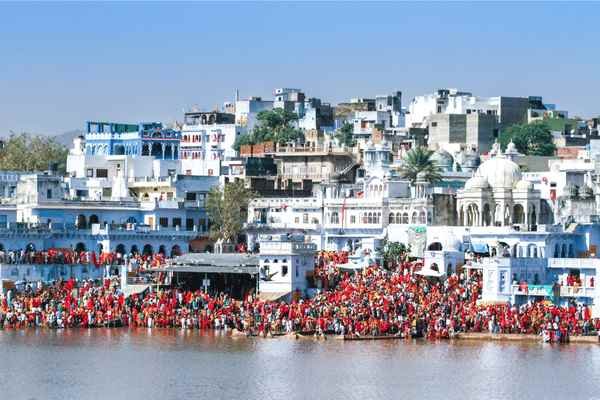
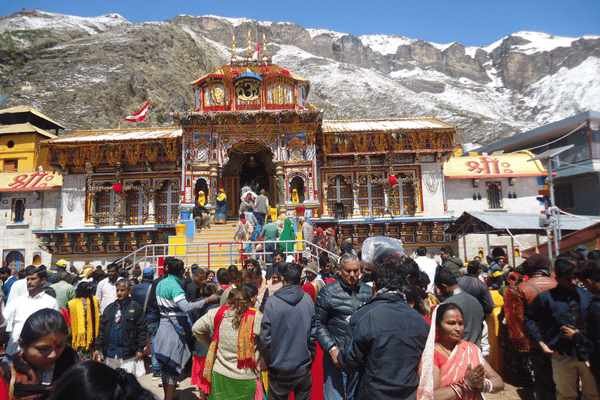
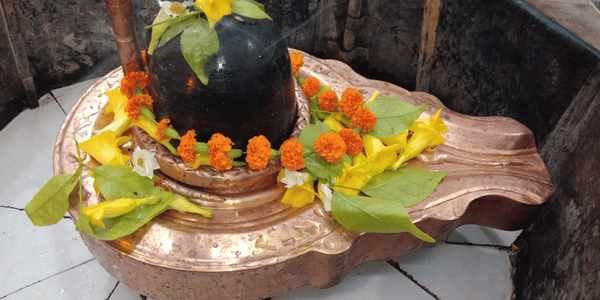
Mahadev Temple
Located on the banks of Pushkar Lake in the heart of the city, Mahadev Temple- also known as Apteshwar Mahadev Temple, is a popular Hindu pilgrimage site in the city of Pushkar. Enshrined by Lord Shiva, the temple was built in the 19th century and boasts of a spectacular architectural style. Constructed in white marbles, the temple house a five faced idol of Lord Mahadev- four of its faces represent the four directions that they face, while the fifth one looks upwards and is a symbol of purity and spiritual progress. The five faces are called Sadyojat, Vamdev, Aghor, Tatpurush and Ishan.
These five faces of Lord Mahadev also represent the five elements – Prithvi, Varun, Vayu, Agni and Akash. Other than that, the idol is adorned in ornaments and jewels. Besides, there are several beautiful carvings and intricate decorations around the walls and the pillars signifying the Hindu deities, gods and goddesses. Mahadev Temple stays especially crowded on the occasion of Shivratri which is celebrated here with a great deal of zeal and fervour.
Pushkar Fair
India’s greatest tribal gathering, Pushkar Mela is held annually in November from Karthik Ekadashi to Karthik Purnima as per the Hindu calendar. It is a grand travel experience held on a vast scale. People visit the fair to witness the beauty of Rajasthani Culture. Attracting more than 400,000 tourists, funky competitions like ‘Matka Tod’, ‘Longest Moustache’, and ‘Bridal Competitions’, are held during the annual Pushkar Fair. Spread over five days, more than 11,000 cattle, horses and camels are part of this visual spectacle.
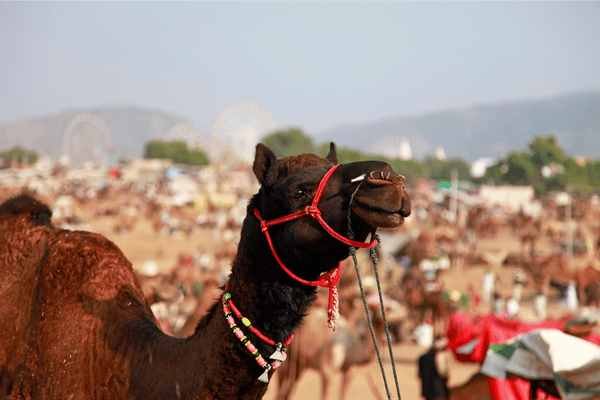
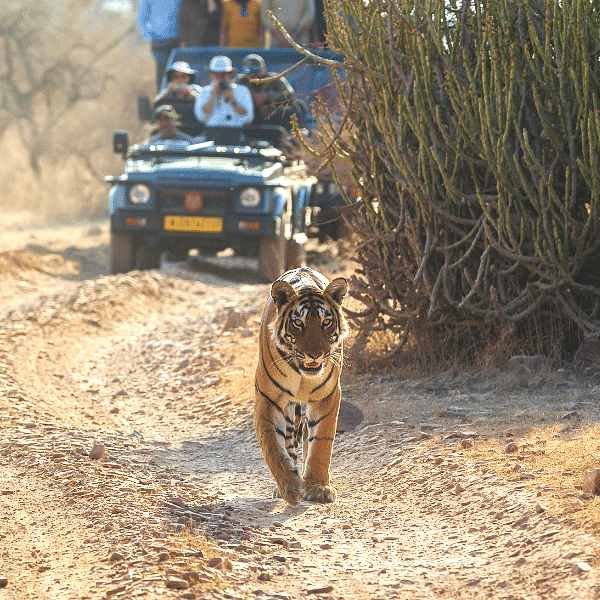
Ranthambore
This is one of the best tiger reserves of the country, known to have “friendly” tigers and chances of sighting one here is reasonably better than many other tiger reserves of India. Along with this Ranthambore has one of the richest flora and fauna making it an absolutely must visit area.
Nestled in the foothills of Vindhya and Aravali Hills, Ranthambore is famous for its tiger reserves and the variety of flora and fauna found. The Ranthambore National Park, along with the Ranthambore Fort and the surrounding hills and valleys, altogether make Ranthambore a traveller’s delight. The place is a boon for wildlife photographers and is perfect for excursions and sightseeing. Safari Rides add to the adventure along with hot Rajasthani picks for shopaholics. With an area of 392 kilometres square, Ranthambore National Park is a natural habitat for a variety of exotic species. It is an absolute delight for birdwatchers and an ideal place to watch animals in their natural habitat.
Ranthambore Tiger Reserve
Spread in an area of 392 sq. Km, the Ranthambore Tiger Reserve is one of the largest and famed tiger reserves in the country, famous for the magnificent Bengal Tiger found there. The Ranthambore Tiger Reserve derives its name from the Ranthambore Fort located in the region. Situated in the Sawai Madhopur district of Rajasthan, it forms a part of Project Tiger reserves, by the Government of India, set up in 1955. Ancient religious ruins found within the forest, surrounded by the rich biodiversity and aesthetically crumbling cenotaphs make Ranthambore Tiger Reserve a favourite spot for photographers, wildlife enthusiasts and travellers.
Among other things, the tiger reserve is known for the medieval hunting trips carried out by the royals of Jaipur when hunting a tiger was the symbol of valour. One can take a safari ride through the jungle and experience watching a tiger in its natural habitat from a few metres away. Dry deciduous forests and marshy grassland forms a distinctive feature of this place with the Aravalli Range and Vindhya Plateau surrounding it to set it apart from the strikingly different desert in the very same state. The Ranthambore Tiger Reserve is also home to a wide variety of flora and fauna. The Sawai Man Singh Sanctuary and Kaldevi Sanctuary that surrounds this tiger reserve became part of the tiger reserve project in the 1990s.
Jeep or Canter Safari is the best way to explore the various zones of the Ranthambore National Park. Wildlife photographers and bird watchers often opt for these safaris to capture thrilling moments in the National Park. Jeep safaris need to be booked well in advance to ensure availability.
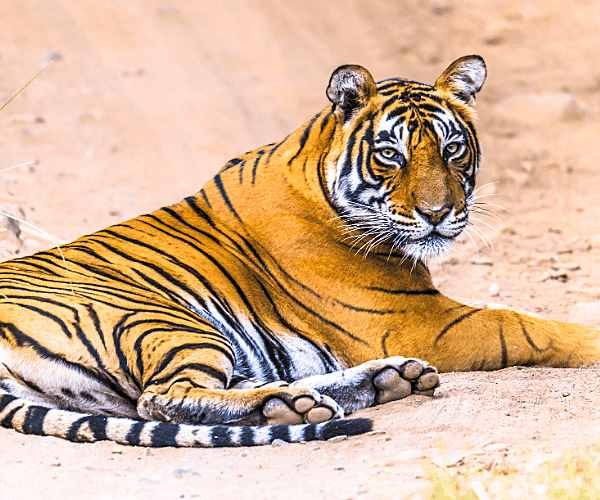
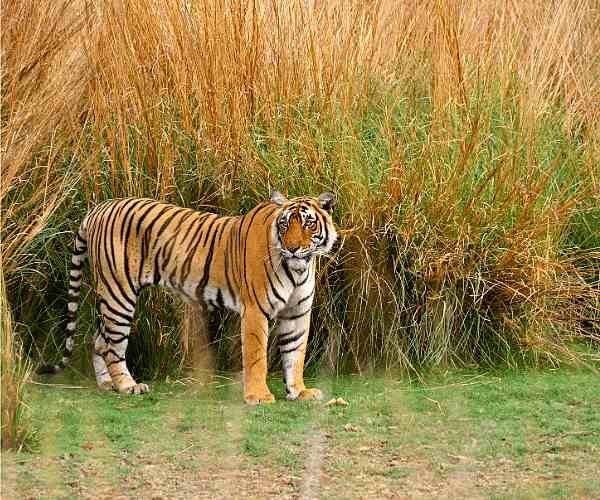
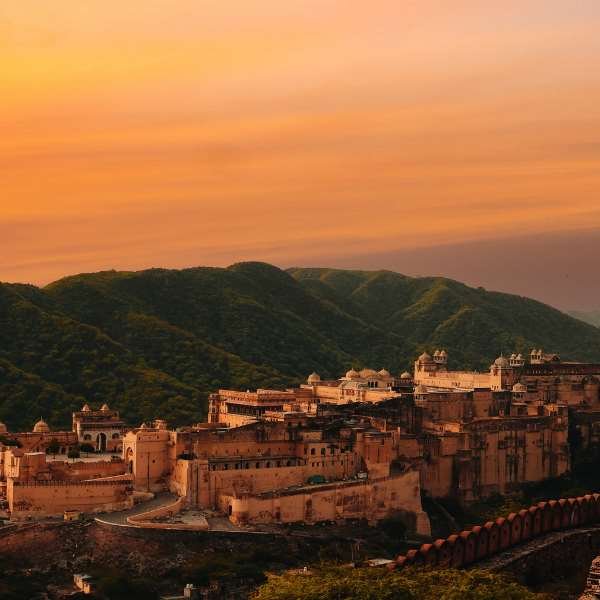
Bharatpur
Bharatpur is located in the Braj region of state Rajasthan, around 38 km from Mathura. Bharatpur is famous for the Keoladeo National Park, which habitats over 370 species of animals and birds. It is recognised as one of the most popular birds feeding and breeding grounds. In 1982 the park was marked as a National Park, and later in 1985, it came on the list of World Heritage Sites by UNESCO. This National Park, locally known as Ghana, has been a winter home for the Siberian Crane; a species on the verge of extinction (considered an endangered bird today).
Bharatpur is drenched by its culture and folklore can be heard from miles. Ruled once by a myriad of rulers, from Jats to Nizams, to the British imperialists, Bharatpur has its own regal history, enshrined in places such as Lohagarh Fort. An exotic offbeat destination that serves tourists with authentic Rajasthani traditions, religious occasions mark devotion of the state people. Also known as Lohagarh, it is a part of the golden tourism triangle of Delhi, Jaipur and Agra, this place attracts a considerable number of national and international tourist every year. Bharat is also a part of the NCR (National Capital Region).
Bharatpur National Park
Now known as the Keoladeo National Park, Bharatpur National Park is a famous avifauna sanctuary and a bird watching paradise listed among UNESCO’s World Heritage sites. The 29 km reserve is locally known as Ghana and is a mosaic of dry grasslands, woodlands, woodland swamps, and wetlands. These diverse habitats are home to 366 bird species, 379 floral species, 50 species of fish, 13 species of snakes, 5 species of lizards, 7 amphibian species,7 turtle species, and a variety of other invertebrates. Every year thousands of migratory waterfowl visit the park for winter breeding.
The sanctuary is one of the richest bird areas in the world. It is a human-made establishment known for nesting of its resident birds and visiting migratory birds including water birds. What is interesting note is that this place was once the waterfowl hunting ground for the royalty and the British, but was converted into an asylum for birds and other wildlife as well in the year 1971. You can take a Jeep Ride or Rickshaw Safari to spot exotic birds and a few animals that inhabit the jungle as well. Bharatpur Bird Sanctuary is easily a bird lover’s paradise, and photographers will find this place to be delightful as well.
